|
A GLOSSARY of MILLED BANDS
|
|
| How to Post Photos |
REGISTER (click here)
|
|
A GLOSSARY of MILLED BANDS
|
|
| How to Post Photos |
REGISTER (click here)
|

|
 SMP Silver Salon Forums SMP Silver Salon Forums
  American Silver before sterling American Silver before sterling
  Water dippers Water dippers
|
| next newest topic | next oldest topic |
| Author | Topic: Water dippers |
|
ahwt Posts: 2334 |
  
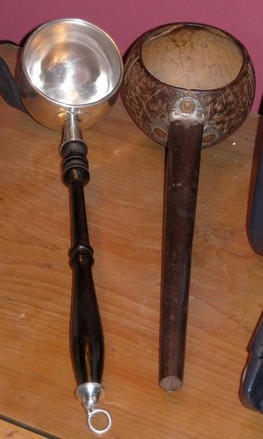 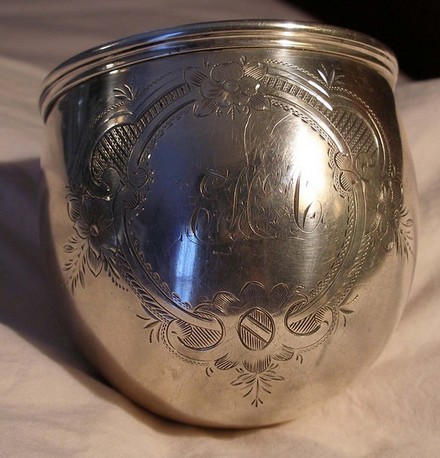 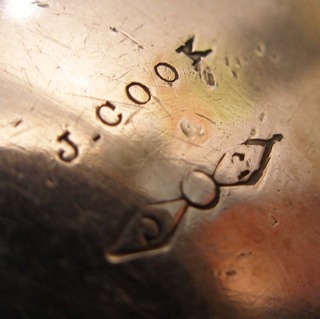 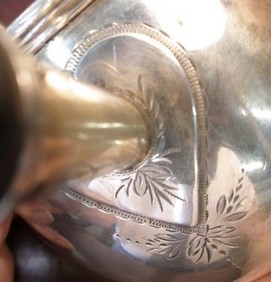 Above are two dippers; one where the bowl is made of silver and one where the bowl is a coconut shell. The silver dipper may be the equivalent of the silver bubble wane of today as it was most likely given to someone who had everything. While it does work well as a dipper, the thought of leaving it hanging by one’s well seems a bit too much. I have also heard that they were used for eggnog or other heavy punches, however the form of the bowl suggests otherwise. The coconut shell dipper has lost its hanging ring and shows sign of use (the tinning on the handle is mostly worn off) while the silver one looks like it mostly hung around on the inside and out of the weather. The use of silver in a water dipper is not very common and from my limited knowledge such dippers seem to have been acquired more by southerners than northerners. This dipper was made by a northerner, John Cook of New York, but by oral history it was initially sold to a Virginia family and later traveled to Alabama as the family moved. Dorothy Rainwater and Judy Redfield indicate in their book “Encyclopedia of American Silver Manufacturers” that Cook was a partner in the Theodore Evans firm until Evans retired in1868 and at that time went into business on his own. Deborah Dependahl Waters, in “Elegant Plate Three Centuries of Precious Metal in New York City” indicates that Evans retired in 1869, rather than 1868 but in either case the dipper was made after the Civil War. If the oral history is correct, southerners must have been acquiring luxury items in the years immediately after the civil war. The construction of this dipper and others I have seen include an extra thickness of silver where the shaft of the handle meets the bowl. I assume this was to provide extra strength and on this dipper the strengthening plate is heart shaped. Any information or reference to any books on silver that discuss these dippers would be appreciated. IP: Logged |
|
Fitzhugh Posts: 136 |
  
I'm quite familiar with these coconut dippers, and yes, they are Southern and have quite early origins. Two have been documented to Kentucky, at least one to Virgina. IP: Logged |
|
William Hood Posts: 271 |
  
I would suggest that your item with the silver bowl is actually a (hot) toddy ladle, the wooden handle keeping the handle from overheating while the ladle is left in the hot liquid. IP: Logged |
|
ahwt Posts: 2334 |
  
The wooden handle would point to using the dipper for a hot drink. Nevertheless, with the eye at the end of the handle I favor its use as a water cup and have it hanging by a water faucet. IP: Logged |
|
Fitzhugh Posts: 136 |
  
Please reference G B Cutten's SILVERSMITHS OF VIRGINIA p.66 under Lynchburg for a particularly fine example of a Va. coconut & silver dipper. Yes, we're pretty sure who made it. Also see Dr. Ben. H. Caldwell's TENNESSEE SILVERSMITHS p. 16 for Samuel Bell's 1825 advertisement in Knoxville for silver mounted "Cocoa Nut" shells. And do let us refer to these as dippers, please, and not toddy ladles, which are a very different form. IP: Logged |
|
ahwt Posts: 2334 |
  
The Third Henry D. Green Symposium of the Decorative Arts was this last weekend and my wife and I thoroughly enjoyed the lectures and the good talk with other participants. The symposium was Friday and Saturday with Saturday afternoon devoted to lectures on silver. Catherine B. Hollan, the author of “In the Neatest, Most Fashionable Manners – Three Centuries of Alexandria Silver” was the first lecturer and provided most interesting commentary on the style and meaning of silver to southerners. She noted that some of the practices of southerners make it difficult for researchers, as southerners it seems do not sell family objects. They also often distribute their personal property before death so that there is no evidence from probate of extant silver objects. Her book on Alexandria silver certainly attests to her ability to find this hidden silver as the silver forms displayed in this book are as extensive as in any book I have seen. Her long awaited book on Virginia silver is to be published next year and all were glad to hear that news. Ms. Hollan was followed by Jennifer Goldsborough who charmed the audience with her wit and provided interesting observations on why certain silver forms were more prevalent in the south and why other forms are absent. The last speaker was Christopher Hartop the author of “The Huguenot Legacy – English Silver 1680-1760 from the Alan and Simone Hartman Collection”. Mr. Hartop provided an interesting commentary on why people of today collect and when this desire to collect started. He feels that it is really a desire to understand how those in the past lived; a need I have always felt showed that a desire for a connection with the past was paramount in my thoughts. He also provided many interesting examples of silver that was used in Colonial homes that was made in England and recounted the interesting story of the Harvard salt. It is my understanding that a book will be published covering all the lectures of this symposium. There was also an unexpected pleasure at this conference as I met a scholar who had researched the history of water dippers in Alabama. He noted that all country homes had a well and that buckets with fresh water from the well were kept by the back door with the dipper hung beside it. Often a water pitcher and basin was kept by the back door for hand washing. Another participant noted that she knew of similar use in Philadelphia and New York. One of the speakers, I believe it was Ms. Hollan, observed that it was not unusual during early American times to have a punch bowl your front door for visiting male quests. Perhaps some households had two dippers. Since many water dippers are unmarked I added photos of one marked with the names of silversmiths from Macon, Georgia. The Day and Mauscent dipper is to the right in the first picture and to the left in the second picture. No manufacturer’s marks appears on this dipper. IP: Logged |
|
ahwt Posts: 2334 |
  
Thought I would add a note that one of the water dippers I saw recently in a house museum had the mark of John Vogler of Salem North Carolina. It would be interesting to know how the dipper traveled from North Carolina to its present location. IP: Logged |
|
ahwt Posts: 2334 |
  
 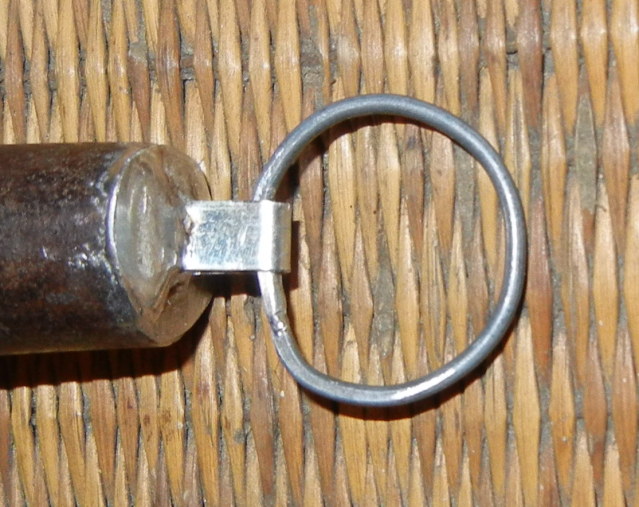 The first post in this series shows a dipper with a missing hanging ring. I recently found a tinsmith in my town and she fashioned a new hanging ring for the end of this dipper. I think she made a very good ring that may be very similar to the original one. The patina is not there yet, but that can only come with time. IP: Logged |
All times are ET | next newest topic | next oldest topic |
  |
|
Ultimate Bulletin Board 5.46a
|
1. Public Silver Forums (open Free membership) - anyone with a valid e-mail address may register. Once you have received your Silver Salon Forum password, and then if you abide by the Silver Salon Forum Guidelines, you may start a thread or post a reply in the New Members' Forum. New Members who show a continued willingness to participate, to completely read and abide by the Guidelines will be allowed to post to the Member Public Forums. 2. Private Silver Salon Forums (invitational or $ donation membership) - The Private Silver Salon Forums require registration and special authorization to view, search, start a thread or to post a reply. Special authorization can be obtained in one of several ways: by Invitation; Annual $ Donation; or via Special Limited Membership. For more details click here (under development). 3. Administrative/Special Private Forums (special membership required) - These forums are reserved for special subjects or administrative discussion. These forums are not open to the public and require special authorization to view or post. |
|
copyright © 1993 - 2022
SM Publications
All Rights Reserved. Legal & Privacy Notices |